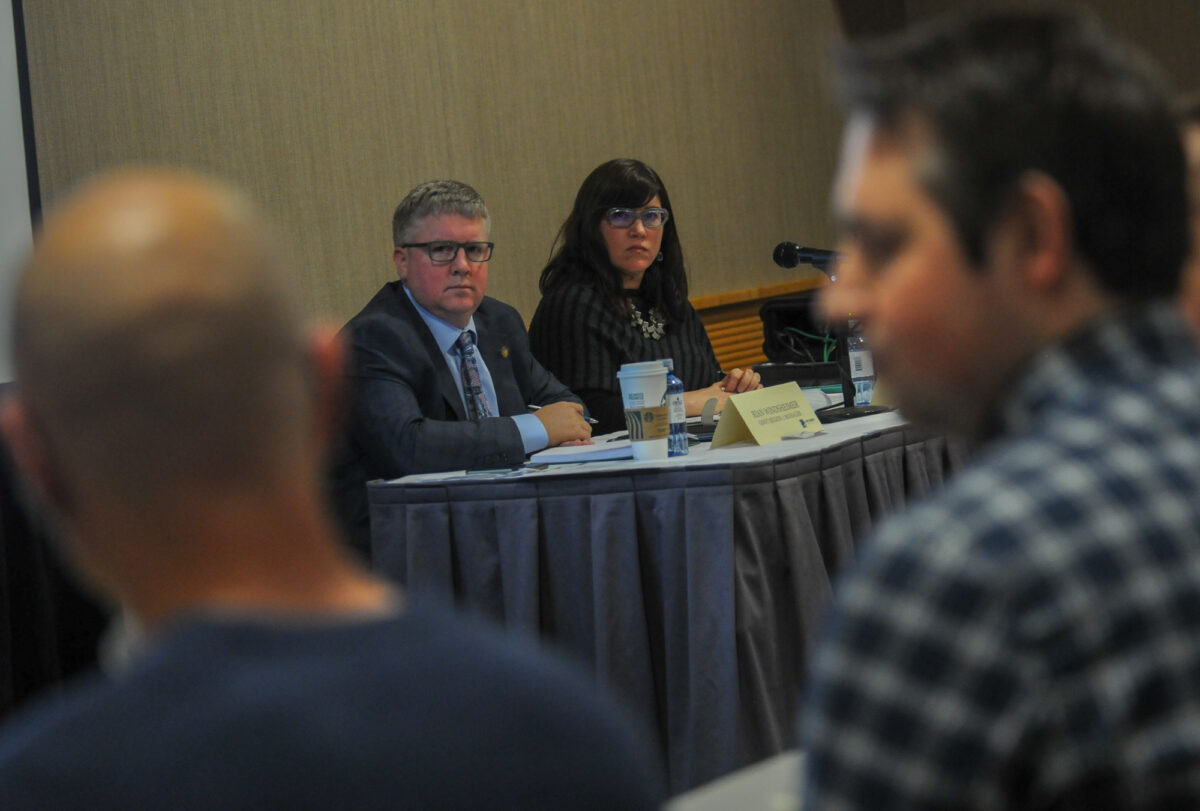
(Photos: Jonathan Maus/BikePortland)
At a public hearing held last night in the Oregon Convention Center, a wide array of Portlanders voiced detailed and passionate opposition to the I-5 Rose Quarter project.
“I don’t necessarily think fixing this poorly designed interchange on I-5 is a terrible idea. We’re not adding capacity at either end of it. We’re trying to clear up a bottleneck right?
— Chloe Eudaly, Commissioner of Transportation
From middle school students to veterans of freeway fights nearly five decades ago, their testimony exposed the myriad significant faults in this project.
People voiced concerns about the health of their children (and future children), the urgent need for investment to stem the carnage on ODOT’s deadly urban highways, the poor design of the freeway lids, the history of institutionalized racism in the original construction of I-5, fears of climate change, the lack of tolling as an option, the inadequacy of proposed bicycling infrastructure, an increase in toxic emissions mere yards away from Harriet Tubman Middle School, induced demand, ODOT’s willful obfuscation and dishonest marketing of the project, and more.
Outside of invited testimony, there were only a couple of people — out of 55 total speakers — who expressed support for the project. There was a large contingent of union reps and workers who think the project will alleviate congestion and provide good-paying jobs. However, several union workers expressed a desire to work with those opposed to the current iteration of the project in hopes of making it better (they really just need something big to build, who says it has to be a wider freeway?).
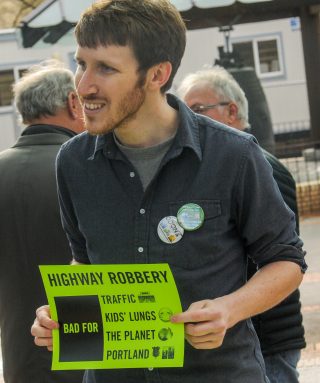
ODOT Region 1 Director Rian Windsheimer and City of Portland Transportation Commissioner Chloe Eudaly sat in the front of the room as panel after panel of concerned people tore into the project from a myriad of angles.
It was nothing short of a complete evisceration of ODOT’s talking points — at an event that was never on ODOT’s schedule and only happened after Commissioner Eudaly (under pressure from her constituents) requested it.
Many people mentioned how ODOT has failed to include key datasets in the Environmental Assessment (EA) that are needed to understand ODOT’s claims and assumptions about traffic volumes and emissions. After listening to two hours of testimony, Commissioner Eudaly (with ODOT’s Windsheimer sitting right next to her) told the crowd, “You have a right to have that data,” and “If it can’t be released in a timely fashion, I will ask for an extension to the comment period.” Windsheimer responded by saying the data would be made available “in the next day or two.”
With just 19 days left in the comment period, every day matters.
Asking the public to weigh in on such an important project with incomplete information is a “travesty, and it’s very disrespectful to our community,” Portlander Sarah Iannarone said in her testimony.
Iannarone also lamented how it seems we, as Portlanders, have “Lost our way” when it comes to leadership on transportation. Then, like many other people throughout the night, she appealed directly to Commissioner Eudaly. “I know that you have courage. I know you have vision. We will have your back if you stand with us on this.” “And to ODOT,” Iannarone concluded, “It’s just not going to happen. We’ll lie down on that highway before you ever build this.”
Advertisement
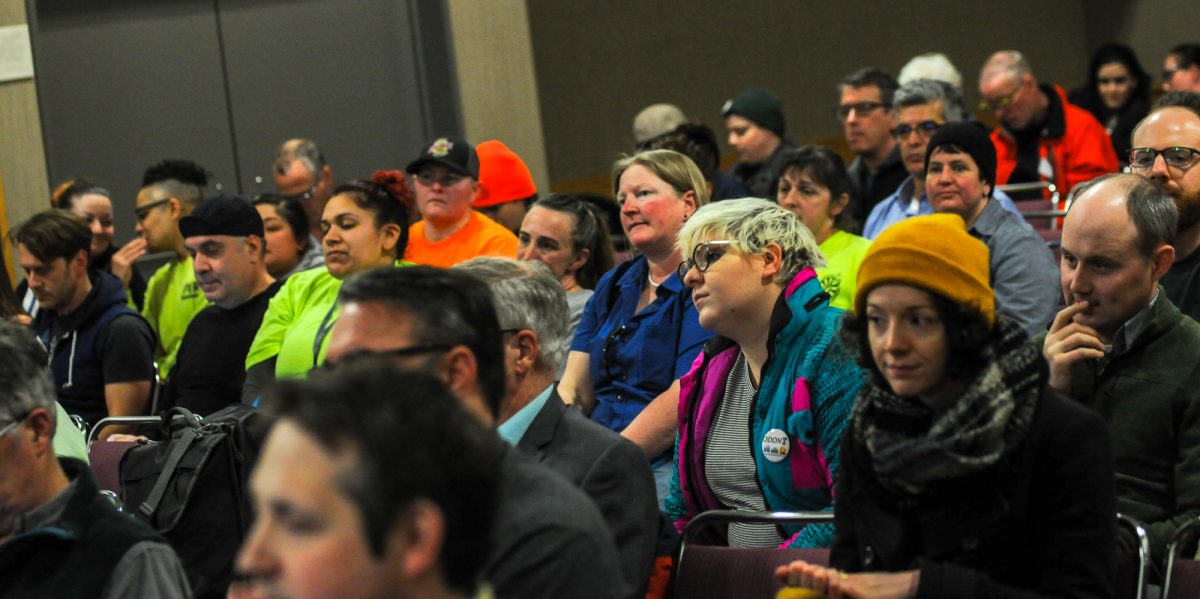
In a lighter moment, St. Johns resident Paul Rippey stood up with his guitar and sang his clever “Induced Demand” tune while many people in the crowd joined him in the chorus: “And the thing we need to understand is, induced demand,” they sang. (We profiled Rippey and shared the lyrics to his song back in May.)
“Black lives matter, black students matter, and black lungs matter.”
— Bryan Chu, teacher at Tubman Middle School
The legacy of past freeway fights in Portland was also a strong thread last night. I counted at least three people who testified and were around and/or a part of stopping the Mt. Hood Freeway and other highway mega-projects of the past. Grant Sawyer from southeast Portland was one of them. He mentioned that during the Mt. Hood Freeway fight, activists and political leaders were able to get highway funds earmarked for the freeway project transferred to other, non-highway uses (like MAX light rail).
“Have you seen the icebergs? They’re melting. They’re melting quickly,” Sawyer said, as his voice rose in volume. “We don’t have time to screw around! To invest any money that enhances fossil fuel use is absolutely insane! Excuse my anger. But I’m pissed!”
His comments about funding prompted a response from Commissioner Eudaly, who said, “This isn’t a PBOT project, this is an ODOT project. This money is from the Highway Trust Fund. As much as I’d like to spend half a billion dollars elsewhere. It’s not my money, and it can only be spent on highways. We can’t take this money and spend it on Vision Zero city streets. It’s ODOT’s money to spend on ODOT’s highways.”
To which Sawyer replied, “That’s what the feds told us in 1975! But we did it!”
Its clear those who oppose this project see Eudaly as a potential ally who might be willing to join fellow Commissioner Jo Ann Hardesty as the second City Council vote against the project. Eudaly has walked a fine line thus far, expressing support for the idea of relieving Rose Quarter congestion and a willingness to partner with ODOT to do it, while also sending signals that she remains uncomfortable with the current plans.
Many testifiers said ODOT should spend this money on deadly streets like 82nd instead of on I-5 where there is no record of deadly or serious injury crashes. During his comments, RJ Sheperd asked everyone to take a moment of silence for Juanita Francisco, the high school student who was hit and nearly killed on February 24th while trying to cross NE 82nd Avenue.
That moment stuck with Eudaly. In her closing remarks she thanked Sheperd for recognizing Francisco and then shared a personal story. “I’m someone who knows what it’s like to lose someone in a traffic crash,” she said. “To live with the knowledge that not only my father, but the two people he killed when he lost control of his vehicle, likely wouldn’t have died if that road had not been so poorly engineered. That is something I feel every time I hear about a serious injury or death on our streets.”
The urgency of the ever-present danger on ODOT-owned arterials was on the mind of northeast Portland resident Clint Culpepper. “If ODOT was truly concerned about safety, they’d spend this money on projects that would save lives tomorrow.”
Children will bear the brunt of decisions made today and many people stood up last night to defend their futures — including a few of the students themselves.
One young student read the definitions of environmental and social justice and then said, “I can see the freeway outside my building. I can also see the thick grey exhaust and that’s scary to think my friends and I are breathing that when we’re running around… If ODOT were to expand the freeway, that would be much worse.”
Bryan Chu teaches eighth graders at Tubman Middle School. He did not mince words in expressing deep concerns about new freeway lanes being built even closer to his classroom.
“PPS [Portland Public Schools] and the Oregon Department of Transportation seem to be highly efficient at perpetuating white supremacy, environmental racism, and placing profit over people and planet while claiming to have our best interests at heart,” Chu said. “But we know better.” Chu added that his students know they’re being lied to when they’re told the air is safe to breathe but see the $10 million HVAC filtration system that sits atop the school’s roof. “They understand we are a frontline community and we are always the ones made to pay the price for Portland’s progress,” he added. He then put a fine point on how he feels racism intersects with this project. “Black lives matter, black students matter, and black lungs matter.”
In her closing remarks, Commissioner Eudaly was measured in her tone. “I feel your desperation about climate change and about air pollution,” she said, before telling the crowd she has always tried to avoid living next to freeways, but, “It’s really hard to escape them.”
The commissioner then said she’d, “Throw Rian [Windsheimer of ODOT] a bone,” and laid out her most detailed comments on the project yet:
“I don’t necessarily think fixing this poorly designed interchange on I-5 is a terrible idea. We’re not adding capacity at either end of it. We’re trying to clear up a bottleneck right? I don’t think we can’t devote any resources to improvements like that. But I do believe we have to make it harder and harder for people to rely on their single-occupancy vehicles while increasing bicycle infrastructure, pedestrian infrastructure, and greatly improving our public transit system. That’s not to say I’m absolutely gung-ho about this. I’m just saying I don’t see it the same way that everyone sees it in this room.”
Then, after reiterating her belief that project funds can’t be switched to different projects, she ended with, “I’m not going to walk away from this conversation. And I hope none of you walk away. I’m convinced we can come up w something better that will better serve our whole community.”
——
Last night was amazing. There were many compelling and substantive comments made from a wide range of people. I recorded all of it (except for a minute or two) and will use them in future stories as needed. You can read more from the hearing in my live twitter thread here.
— Jonathan Maus: (503) 706-8804, @jonathan_maus on Twitter and jonathan@bikeportland.org
Never miss a story. Sign-up for the daily BP Headlines email.
BikePortland needs your support.


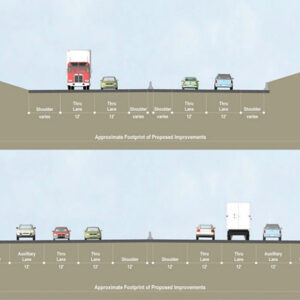
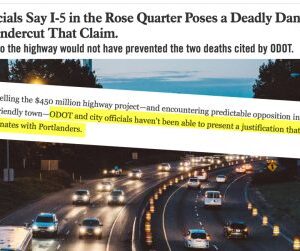
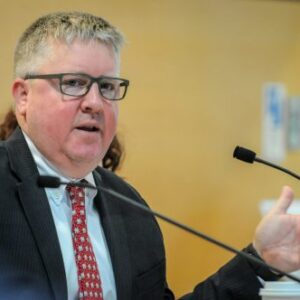
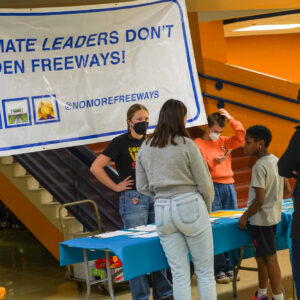
Thanks for reading.
BikePortland has served this community with independent community journalism since 2005. We rely on subscriptions from readers like you to survive. Your financial support is vital in keeping this valuable resource alive and well.
Please subscribe today to strengthen and expand our work.
“We’re not adding capacity at either end of it. We’re trying to clear up a bottleneck right? ”
This is the key point that I and others have been saying for a long time. Highway expansion is generally a bad idea for reasons well known on this site but this particular issue is about fixing a design flaw more than it is about highway expansion. I must admit I’m impressed with Chloe for saying it.
Four-hundred
fifty
million dollars
Less room for Incense Cedar trees to block noise and dark smoke for the old public school.
Let’s say it cost just $500, would you support it? Many times I hear someone list the price and that is simply a handy excuse for them – often times they are opposed no matter what and the price has nothing to do with it.
Is it a genuine safety issue? Then, sure!
I would not support it even if it were free.
Exactly.
A $500 million design flaw. Given the “design flaws” in nearly every major street in Portland that prioritizes SOVs over people on bikes and people walking, it’s curious that we are considering “fixing” 1/4 mile of highway versus 50-100 miles of streets. Which might have a more lasting effect on safety and making Portland a better place?
Actually, they are doing exactly what they were “designed” to do. The fact that you don’t like the design doesn’t make it a design flaw.
Absolutely true. I hope my opinion has little to no bearing on how streets are designed. Continued research, best practices (eg NACTO), and ultimately convergence of evidence should lead our representatives to design safe streets.
The design flaw is that all these ramps exist close together in the central city.
The solution is to close these ramps, not to make their access easier and encourage more motor vehicles through the area.
SOV VMT is SOV VMT
Most DOTs advertise highway widenings as “bottleneck relief.” That’s pretty standard fare in marketing for this stuff. The fact is bottleneck relief is a never ending chase and leads to highways like LA and Houston. The I5 bridge to Vancouver is also a “bottleneck” So let’s make it 15 lanes. But, now 15 lanes goes to 10 in Vancouver so here’s a new bottle neck! It’s a poor use of funds especially because funds are limited and could be used for better tasks. If we had robust public transit and robust ridership, safe PBOT/ODOT streets, and this was the last task, I might say okay, let’s look at this project. However, this is not the situation.
“That’s what the feds told us in 1975! But we did it!”
Federal law allowed for such transfers in the 70s. That’s no longer the case. This is a dead end talking point.
OK, I’m confused. I thought this was State of Oregon money and that the project has to go through the FHWA NEPA process because of it being part of the interstate highway system, not because of the funding source. Didn’t the project get funded through HB 2017, the same bill that established a statewide transit payroll tax?
It’s effectively an earmark of federal gas tax revenue, so federal rules apply.
Can you or others provide a reference that clarifies the funding mechanism and limitations? This question seems worthy of a more detailed analysis as it is likely the most important factor considered by officials.
My understanding is that any public agency or jurisdiction that uses any federal money, whether for this project or any other, must follow federal guidelines and rules for all their projects, no matter where the money is coming from. The rule comes from the same source as NEPA, from a series of civil rights laws from the 1960s. In most cases, “environment” refers to demographics of vulnerable people who are negatively affect by such projects, not necessarily to biological ecosystems. ODOT is an agency within the State of Oregon. It’s the State of Oregon that’s doing this project, represented by ODOT. And the state of Oregon & the City of Portland both use a lot of federal money.
It would be great to see an article about the actual language that describes the source of the funding and the stipulations on the funding as well as an analysis by an expert at the state level whose job it is to know all of the intricate details.
I’ve read it. Others on this site have too. It’s VERY long, in federal bureaucratese in “Federal Bulletin” style writing, very hard to read, a sure cure for insomnia. Feel fortunate that we don’t (or aren’t allowed to by Jonathan) reproduce it here – you would find it torture, worse than water-boarding.
Wrong. Its state funds. State funds. Read HB2017.
It’s pretty dismaying that our elected officials (Eudaly) know so little about the funding situation for this project. The facts are that no federal funding has been allocated for construction and the state funds directed towards this project are contingent on there actually being a scoped project to build.
So while it wouldn’t be a clean process to simply transfer state funding targeted towards RQ to some other project, there’s nothing that says the state must spend the funding on RQ. They could simply choose to not spend it on that project.
Also, is anyone reaching out to the FHWA office in Salem, and Reps. Blumenauer and DeFazio to express their disapproval? ODOT will undoubtedly ignore all of the public input and advance this project for federal funding, so trying to kill it at that level is also an option.
You are right. Some of the funding for outer Powell comes from the cancelled CRC project, the $27 million that would have been spent annually just to pay the bonds on that project. State transportation monies can be pretty easily reallocated by the state legislature towards other transportation projects, as can Council for the $50 million 10+% city match for this project.
Stop letting Commissioner Eudaly peddle this lie. Her father was drunk and driving over twice the speed limit.
I think Eudaly has a point. If the road were engineered so that 15 or 20 mph were the speed that felt comfortable to an unimpaired driver, then someone whose judgment and sense of comfort was impaired to the extent of her father’s (going over twice the advised speed on the curve) might have been going 40 or 45 mph rather than 65-70mph. Which might well have saved a life or two.
Indeed, this point is one of the central tenets of Vision Zero: planning for harm reduction when road users do make bad decisions. Knowing Eudaly said this increases the extent to which I believe she understands Vision Zero.
I mean sure, but driving 75 mph with a BAC of .12 surely was the primary factor in the crash and not the design of the road. At some point there has to be some personal responsibility here – driving drunk is illegal for a reason. Telling this story while conveniently leaving out the DUI portion is a lie by omission and Commissioner Eudaly knows it because she keeps retelling the same story to fit whatever the issue of the day is.
The sins of the father are not visited upon the daughter. I think we should give her a break. Her dad died, too. It doesn’t diminish *his* culpability, but it sure as hell has some bearing on her feelings and motivations.
The Commissioner isn’t lying. Whatever poor decisions her father made, I think the Commissioner is expressing a genuine, heartfelt statement of solidarity with the need to design a transportation system in which poor decisions don’t lead to violent, bloody death. She is articulating a need to implement harm-reduction, and seems to be doing her best to gracefully reconcile her father’s actions with her opportunity as an elected public official to eradicate these awful tragedies from happening. Cut her some slack.
eawriste makes a very good point. This “design flaw” creates congestion. There are many design flaws that result in the deaths of bicyclists and pedestrians over and over again, like the lack of a protected network or safe crossings.
“This “design flaw” creates congestion.”
All the motor vehicles are what causes the congestion. People choose the worst form of transportation and then expect the rest of us to pay the price.
There’s nothing wrong with letting motor vehicle commuters have their way and letting them sit idle on the freeway.
What’s wrong is trying to put more of them there on our dime. This isn’t going to be fixed by luring more people into the congestion machine. If you want less people stuck on the freeway then lure them off the freeway.
Your argument is that its ‘your dime’ – but most taxpayers drive as opposed to bike (some of us do both).
If there were no sidewalks, everyone would drive. People don’t bike because there is very little infrastructure. Bikes don’t protect people from death. In cities where safe (physically separated) infrastructure exists, the mode share is dramatically different. It would be the same in Portland given just a fraction of the public subsidy and investment given to SOVs.
“We’re not adding capacity at either end of it. We’re trying to clear up a bottleneck right?”
She echoes an ODOT talking point and then questions it, as if trying to make a statement but know it’s false.
They’re adding a freeway lane for onramp and offramp traffic. This will increase lane merges by 1 to 2, which will slow the freeway down by that much.
The added lanes will be full of stopped traffic trying to merge onto the highway. People will illegally force their way into traffic, causing the freeway to slow down even more. Law abiding citizens will be forced to exit the freeway because there’s no gap to merge into traffic. and then travel the city streets until the next exit. Connected “auxiliary” onramp lanes don’t put you on the freeway, they put you on the exit ramp. The same fiasco they’re creating on I-205 right now.
Not only will this encourage more motor vehicle use (induced demand is well proven), but more illegal use as well (cutting off freeway traffic, stopping in the “aux” lane).
Nothing good can come from this project. It’s so obvious to anybody that knows anything about highway design and human behavior. Everybody involved should be ashamed.
Building and expanding highways is a lot like war and banking. The feedback and opinions of the masses are not really welcome, the agenda has been set and the big players already have a spot at the trough reserved. Our only hope is to make so much trouble that this one becomes unpalatable for them and they move on.
I’m most disappointed in Commissioner Eudaly. She has lost my vote for a re-election campaign. I thought she would be a progressive champion to help combat climate change, end systemic oppression of historically marginalized groups, and that she would actually be a visionary on these issues. To claim that it’s ODOT money and we can’t do anything is ridiculous. Pulling PBOT support would be a seismic shift for starters that would turn heads at the state. Second, these funds could be transferred to other ODOT highways like 82nd, Powell, Lombard and other high crash corrdors that run through Portland where people are dying right now and lives could be saved as soon as safer facilities are implemented. $500 million is enough funding to implement safety features up and down all of those roads! ODOT has habitually ignored communities along those dangerous ODOT streets, and claims they don’t have the funding for broad fixes. That Commissioner Eudaly would push the same line is the biggest disappointment of the night. Of course, the one POC on the City Council actually understands who is being oppressed yet again and who is being served by this project.
HB 2017 specifically designates money for the Rose Quarter project. It was mentioned by name in the bill to ensure that it would get funding. I would think that would mean that the state legislature would need to amend the bill to remove funding for the project.
I might be wrong and happy to be corrected, but I don’t think it’s been funded. There is a plan to fund it via bonds (I think that’s the mechanism). I know that’s nitpicky but it does mean we arent yet paying interest and that there is still time to try to stop it or amend the project.
I agree the funding is specific to this project; however, they could not proceed with the project and never fund it through bonds either. The legislature could instead fund ODOT in separate legislation for their orphan highway handover or as you said, amend it. However, I do reject Eudaly’s assertion that the money goes “poof” if it isn’t spent here.
The “middle of the road cyclist” guy posited what would get someone to support the project and it did make me think. I do think our funding is zero sum so money spent here means more people die on 82nd. I would say, as i said in another comment, if we made our surface streets safe for all users, and still had funding left over, I would happily look at this project if it included buildable caps and a exhaust treatment system to the community here isn’t hit. That’s also wishful thinking – but I did think MOTRC guy’s question was interesting.
In many state, including mine (NC), highway funding follows an allocation formula based on state legislation (usually from the 1960s or 70s): a certain very low percentage for bike and walk projects; a slightly higher percentage for transit projects and subsidies; a much larger percentage for rural roads; higher still for trunk roads and orphan highways; and at least half towards interstate (divided) highways. I’m not sure where Oregon’s allocation specs are located, but if I had to guess, it’s likely in the same piece of legislation as “1% for bikes”.
I don’t know how the funding works but it is designated to get $30 Million per year starting in 2022 until the bonds are paid off.
The challenge will be keeping the money in Portland if the project isn’t funded. The Rose Quarter project is outside of the Region 1 funded project list. I’m afraid the money would go back to Salem and be divided amongst the next highest priority freeway projects. (or maybe a revived Columbia River Crossing)
Regardless it will push back from city council and metro to stop the project at this point.
I’m pretty sure the money would get spent within Region 1 (Multnomah, Clackamas, Washington, & Hood River counties), but it’s ultimately up to the state legislature.
That is correct. Somewhat oddly (and somewhat deceptively) it never quotes the full cost with interest payments, but instead it says “For calendar years beginning on or after January 1, 2022, $30 million shall be used for the Interstate 5 Rose Quarter Project”. However, if the project cost is $450 million and the interest rate is 4.5 percent, over 25 years of payments the total cost (with interest) is $760 million).
If I’m ambivalent about and a neighbor to the Rose Quarter expansion, then the safety of other ODOT roads is an issue that resonates with me in ways that the other arguments don’t. Call the project anything you like, but if “bottleneck relief” or “highway expansion” is more important than human lives, I think “messed up” is more appropriate.
This is an urban renewal decision by Portland planners. There have been documents citing the “N/NE Quadrant” and “Broadway-Weidler” plan for years. The basic plan is to encourage high density development in the Coliseum and South Albina area. Just like the Pearl District was planned, starting 15 years ago, and the Central Eastside District is currently underway. However, it is smart planning to take care of the transportation infrastructure BEFORE they allow 20 story buildings to be put in. So ODOT is not your real target, it’s merely the state agency trying to coordinate the transportation portion of the larger, urban renewal plan. Which has been in the works for the last decade.
In other words, the ship has already sailed.
True, but numerous ships in Portland have run aground…
It is not surprising… Eudaly is in so far over her head.. she does even have a clue about transportation issues…
“It was nothing short of a complete evisceration of ODOT’s talking points”
In your title, I think you might be looking for something like sustains? To weather something means to survive intact. That may ultimately be so, but your characterization of the testimony is not aligned with the meaning of that word.
yes that headline has not sat well with me from the start. just changed it to “roundly rejected”. thanks.
I find it very hard to sympathize with anyone at Tubman school with all the driving those parents do. How about leading by example?
Got to hand it to that climate mayor of ours. Scaring granny into supporting this project by suggesting that medicine won’t be able to reach hospitals without a freeway widening. Good grief
When’s the next Global Climate Action Summit Ted?
It is possible to track positions of gigantic “cruise” ships on the web as they emit sulfur-laden exhaust from 100,000 horsepower agglomerations of medium speed diesel engines onto remote tropical communities.
What if they are powered by hot air and guided like a ship of state, the only kind of ship that leaks from the top?
I wonder if anyone here knows how much carbon a large building heated 24/7 emits into the air? Certainly, natural gas is a lower CO2 emitter than petroleum or coal. OTOH a big building that is heated all winter uses A LOT of natural gas. Just imagine how much more CO2 is emitted from the Pearl District with all of those tall buildings being heated now, where there used to be one floor shops. And on the east side they are building thousands of CO2 emitting apartments as well. And just wait until the N/NE Quadrant takes off. CO2 up the ying yang! And then, there are all of those big, drafty houses around Portland just gobbling up the energy.
But then, Portland’s political establishment LOVES all of that extra property tax money coming into their coffers. Think about it.
The only number that matters is the total emissions. The overloaded atmosphere and oceans couldn’t care less about the denominator, about how many people or buildings we wish to divide our emissions by.
“natural gas is a lower CO2 emitter than petroleum or coal”
as you suggest, not that relevant.
Total emissions are soaring in Portland. And like I say, nearly every building is heated 24/7 in the winter months. Some individual owners, like me, practically turn the heat off at night. Not so much in big office buildings, commercial buildings and multi family apartment or condominium buildings. Plus natural gas is only 40 percent lower on CO2 than coal; but it is essentially methane, so that is a greenhouse gas too.
But all of these new, huge building using natural gas 6 or 7 months out of the year are not only increasing our city’s carbon footprint. They also bring in lots of tax money to the local governments. Do you like the liberal politicians bringing in lots of money for their ideas?
Recently our “ships of state” have been “guided” by the likes of Madeline Albright, Condaleeza Rice, Hillary Rodham. We should ask them.
When I wrote “ship of state”, I meant any jurisdiction with taxing authority run by elected officials, including your state and city. Oftentimes the people near or at the top are the most likely to “leak” anonymously to the press, including the people at the very top. And of course they all blow hot air, Eudaly as much as anyone else.
“They’re adding a freeway lane for onramp and offramp traffic. This will increase lane merges by 1 to 2, which will slow the freeway down by that much”
Exactly. It will keep 84 to 405 thru-traffic off I-5 but it does nothing to separate it from vehicles entering and exiting. I fail to see how this will improve safety as you will be forced to cross another lane of traffic doing the opposite of what you need to do. Plus the distances between the existing exits provide little room to merge safely. It may reduce the risk of rear-end collisions on I-5 but it increases the risk of collisions in the new auxiliary lane. The project will not address the two key arguments put forth by ODOT, namely alleviating congestion and improving safety. At best they are going to spend $500M for zero gain. The design is flawed.
I remember when she was running for city counsel. It’s amazing how quickly the reigns of power will transform a vocal advocate for progress, into an establishment shill. Sad to see.
the west side of the Merquam Bridge is the real bottle neck..
just a terrible design…why do i need to get into the slow lane to stay on I 5 …oh and if your going south I5, lets pair it down to one lane and merge…just stupied
No matter what you think of the Rose Quarter project it’s still a heckuva lot cheaper than another proposal that Portlanders like to talk about: “Removing” I-5. Which translates to changing the location by several blocks and putting it on two levels. We’re talking at least $10 billion here. With a Rose Qaurter project and a needed western metropolitan route we’re still at a small fraction of what “I-5 Removal” would cost!
The Rose Quarter project is just simply smart planning. So stop directing your ire at ODOT, which is caught in the middle of things.
Removing I-5 would provide a much greater RoI.